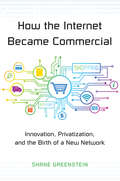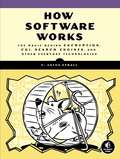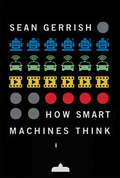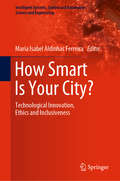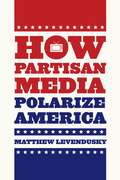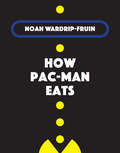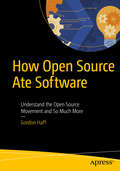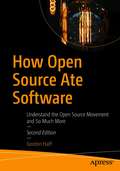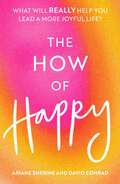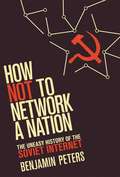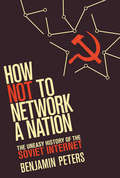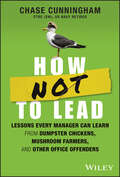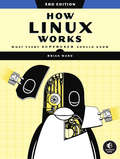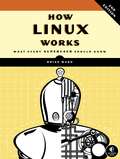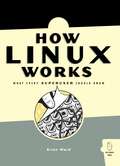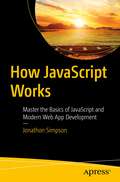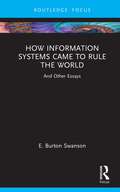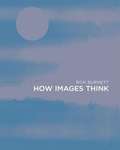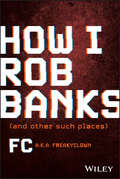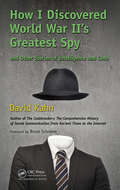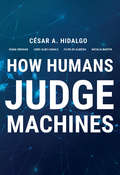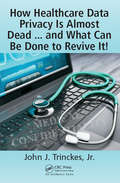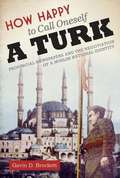- Table View
- List View
How the Internet Became Commercial
by Shane GreensteinIn less than a decade, the Internet went from being a series of loosely connected networks used by universities and the military to the powerful commercial engine it is today. This book describes how many of the key innovations that made this possible came from entrepreneurs and iconoclasts who were outside the mainstream--and how the commercialization of the Internet was by no means a foregone conclusion at its outset.Shane Greenstein traces the evolution of the Internet from government ownership to privatization to the commercial Internet we know today. This is a story of innovation from the edges. Greenstein shows how mainstream service providers that had traditionally been leaders in the old-market economy became threatened by innovations from industry outsiders who saw economic opportunities where others didn't--and how these mainstream firms had no choice but to innovate themselves. New models were tried: some succeeded, some failed. Commercial markets turned innovations into valuable products and services as the Internet evolved in those markets. New business processes had to be created from scratch as a network originally intended for research and military defense had to deal with network interconnectivity, the needs of commercial users, and a host of challenges with implementing innovative new services.How the Internet Became Commercial demonstrates how, without any central authority, a unique and vibrant interplay between government and private industry transformed the Internet.
How Software Works: The Magic Behind Encryption, CGI, Search Engines, and Other Everyday Technologies
by V. Anton SpraulWe use software every day to perform all kinds of magical, powerful tasks. It's the force behind stunning CGI graphics, safe online shopping, and speedy Google searches. Software drives the modern world, but its inner workings remain a mystery to many.How Software Works explains how computers perform common-yet-amazing tasks that we take for granted every day.Inside you'll learn:–How data is encrypted–How passwords are used and protected–How computer graphics are created–How video is compressed for streaming and storage–How data is searched (and found) in huge databases–How programs can work together on the same problem without conflict–How data travels over the InternetHow Software Works breaks down these processes with patient explanations and intuitive diagrams so that anyone can understand—no technical background is required, and you won't be reading through any code. In plain English, you'll examine the intricate logic behind the technologies you constantly use but never understood.If you've ever wondered what really goes on behind your computer screen, How Software Works will give you fascinating look into the software all around you.
How Smart Machines Think (The\mit Press Ser.)
by Sean GerrishEverything you've always wanted to know about self-driving cars, Netflix recommendations, IBM's Watson, and video game-playing computer programs.The future is here: Self-driving cars are on the streets, an algorithm gives you movie and TV recommendations, IBM's Watson triumphed on Jeopardy over puny human brains, computer programs can be trained to play Atari games. But how do all these things work? In this book, Sean Gerrish offers an engaging and accessible overview of the breakthroughs in artificial intelligence and machine learning that have made today's machines so smart.Gerrish outlines some of the key ideas that enable intelligent machines to perceive and interact with the world. He describes the software architecture that allows self-driving cars to stay on the road and to navigate crowded urban environments; the million-dollar Netflix competition for a better recommendation engine (which had an unexpected ending); and how programmers trained computers to perform certain behaviors by offering them treats, as if they were training a dog. He explains how artificial neural networks enable computers to perceive the world—and to play Atari video games better than humans. He explains Watson's famous victory on Jeopardy, and he looks at how computers play games, describing AlphaGo and Deep Blue, which beat reigning world champions at the strategy games of Go and chess. Computers have not yet mastered everything, however; Gerrish outlines the difficulties in creating intelligent agents that can successfully play video games like StarCraft that have evaded solution—at least for now. Gerrish weaves the stories behind these breakthroughs into the narrative, introducing readers to many of the researchers involved, and keeping technical details to a minimum. Science and technology buffs will find this book an essential guide to a future in which machines can outsmart people.
How Smart Is Your City?: Technological Innovation, Ethics and Inclusiveness (Intelligent Systems, Control and Automation: Science and Engineering #98)
by Maria Isabel Aldinhas FerreiraThis book focuses on the potential benefits that the so-called smart technologies have been bringing to the urban reality and to the management and governance of the city, simultaneously highlighting the necessity for its responsible and ethically guided deployment, respecting essential humanistic values. The urban ecosystem has been, in the last decades, the locus to where the most advanced forms of technological innovation converge, creating intelligent management platforms meant to produce models of energy, water consumption, mobility/transportation, waste management and efficient cities. Due to the coincidence of the punctual overlap of its own genesis with the pandemics outbreak, the present book came to embody both the initial dream and desire of an intelligent city place of innovation, development and equity – a dream present in most of the chapters – and the fear not just of the pandemics per se, but of the consequences that this may have for the character of the intelligent city and for the nature of its relationship with its dwellers that, like a mother, it is supposed to nurture, shelter and protect.
How Partisan Media Polarize America
by Matthew LevenduskyForty years ago, viewers who wanted to watch the news could only choose from among the major broadcast networks, all of which presented the same news without any particular point of view. Today we have a much broader array of choices, including cable channels offering a partisan take. With partisan programs gaining in popularity, some argue that they are polarizing American politics, while others counter that only a tiny portion of the population watches such programs and that their viewers tend to already hold similar beliefs. <P><P> In How Partisan Media Polarize America, Matthew Levendusky confirms--but also qualifies--both of these claims. Drawing on experiments and survey data, he shows that Americans who watch partisan programming do become more certain of their beliefs and less willing to weigh the merits of opposing views or to compromise. And while only a small segment of the American population watches partisan media programs, those who do tend to be more politically engaged, and their effects on national politics are therefore far-reaching. <P>< In a time when politics seem doomed to partisan discord, How Partisan Media Polarize America offers a much-needed clarification of the role partisan media might play.
How Pac-Man Eats
by Noah Wardrip-FruinHow the tools and concepts for making games are connected to what games can and do mean; with examples ranging from Papers, Please to Dys4ia.In How Pac-Man Eats, Noah Wardrip-Fruin considers two questions: What are the fundamental ways that games work? And how can games be about something? Wardrip-Fruin argues that the two issues are related. Bridging formalist and culturally engaged approaches, he shows how the tools and concepts for making games are connected to what games can and do mean.
How Open Source Ate Software: Understand The Open Source Movement And So Much More
by Gordon HaffLearn how free software became open source and how you can sell open source software. This book provides a historical context of how open source has thoroughly transformed how we write software, how we cooperate, how we communicate, how we organize, and, ultimately, how we think about business values.You’ll look at project and community examples including Linux, BSD, Apache, and Kubernetes, understand the open source development model, and how open source has influenced approaches more broadly, even proprietary software, such as open betas. You'll also examine the flipside, the "Second Machine Age," and the challenges of open source-based business models.Today, open source serves as shorthand for much broader trends and behaviors. It’s not just about a free (in all senses of the word) alternative to commercial software. It increasingly is the new commercial software. How Open Source Ate Software reveals how open source has much in common, and is often closely allied, with many other trends in business and society. You'll see how it enables projects that go beyond any individual company. That makes open source not just a story about software, but a story about almost everything.What You'll LearnUnderstand open source opportunities and challengesSell software if you’re giving it awayApply open source principles more broadly to openorg, devops, etc.Review which organizational incentives you can implement Who This Book Is ForAnyone who has an interest in what is happening in open source and the open source community, and anyone who is contemplating making a business that involves open source.
How Open Source Ate Software: Understand the Open Source Movement and So Much More
by Gordon HaffLearn how free software became open source and how you can sell open source software. This book provides a historical context of how open source has thoroughly transformed how we write software, how we cooperate, how we communicate, how we organize, and, ultimately, how we think about business values. This fully updated second edition includes an entire chapter on legal considerations such as trademarks and the latest happenings in open source licensing. It also expands on open hardware trends such as RISC-V, open governance, and the difference between community projects and commercial products, especially as seen through the lens of security. You’ll look at project and community examples including Linux, BSD, Apache, and Kubernetes, understand the open source development model, and how open source has influenced approaches more broadly, even within proprietary software, such as open betas. You'll also examine the flipside, the "Second Machine Age," and the challenges of open source-based business models. Today, open source serves as shorthand for much broader trends and behaviors. It’s not just about a free (in all senses of the word) alternative to commercial software. It increasingly is the new commercial software. How Open Source Ate Software, second edition reveals how open source has much in common, and is often closely allied, with many other trends in business and society. You'll see how it enables projects that go beyond any individual company. That makes open source not just a story about software, but a story about almost everything. What You'll Learn The opportunities that open source creates and the challenges that come with themThe ways in which companies can create business models to successfully sell "free" softwareHow the open source development model works from creating communities to selling commercial productsThe important issues associated with open source project and product governance and licensingHow open source principles can apply more broadly to DevOps and other organizational practices Who This Book Is For Anyone who is contemplating building a community and a business around open source software.
The How of Happy: What will REALLY help you lead a more joyful life?
by Ariane Sherine David ConradHappiness: as elusive as a working inkjet printer, and as slippery as an eel covered in baby oil. When we chase happiness, it runs away like a cat when you're trying to give it a bath, but the world of pop psychology is filled with competing advice that either claims it can help you catch it or warns you not to seek it out at all. Comedian Ariane Sherine is determined to help us find the true path to happiness, and public health expert David Conrad has the key: 50 well-selected research studies that show you exactly what to do to find happiness in your relationships, your friendships, your finances, your sex life and your career. Using wide-ranging evidence from around the world, Conrad and Sherine show us the true science behind what makes people happy and outline the simple, practical steps we can take to attain this too. This book has all the facts, stats and entertainment you could ever need to live a blissfully content life. And celebrities weigh in with their own versions of happiness too, so you'll find contributions from Derren Brown, Stewart Lee, Jeremy Vine, Rosie Holt, Femi Oluwole, Robin Ince, Sanjeev Kohli, Bec Hill, Arthur Smith and many more.
The How of Happy: What will REALLY help you lead a more joyful life?
by Ariane Sherine David ConradHappiness: as elusive as a working inkjet printer, and as slippery as an eel covered in baby oil. When we chase happiness, it runs away like a cat when you're trying to give it a bath, but the world of pop psychology is filled with competing advice that either claims it can help you catch it or warns you not to seek it out at all. Comedian Ariane Sherine is determined to help us find the true path to happiness, and public health expert David Conrad has the key: 50 well-selected research studies that show you exactly what to do to find happiness in your relationships, your friendships, your finances, your sex life and your career. Using wide-ranging evidence from around the world, Conrad and Sherine show us the true science behind what makes people happy and outline the simple, practical steps we can take to attain this too. This book has all the facts, stats and entertainment you could ever need to live a blissfully content life. And celebrities weigh in with their own versions of happiness too, so you'll find contributions from Derren Brown, Stewart Lee, Jeremy Vine, Rosie Holt, Femi Oluwole, Robin Ince, Sanjeev Kohli, Bec Hill, Arthur Smith and many more.
How Not to Network a Nation: The Uneasy History of the Soviet Internet
by Benjamin PetersBetween 1959 and 1989, Soviet scientists and officials made numerous attempts to network their nation -- to construct a nationwide computer network. None of these attempts succeeded, and the enterprise had been abandoned by the time the Soviet Union fell apart. Meanwhile, ARPANET, the American precursor to the Internet, went online in 1969. Why did the Soviet network, with top-level scientists and patriotic incentives, fail while the American network succeeded? In How Not to Network a Nation, Benjamin Peters reverses the usual cold war dualities and argues that the American ARPANET took shape thanks to well-managed state subsidies and collaborative research environments and the Soviet network projects stumbled because of unregulated competition among self-interested institutions, bureaucrats, and others. The capitalists behaved like socialists while the socialists behaved like capitalists. After examining the midcentury rise of cybernetics, the science of self-governing systems, and the emergence in the Soviet Union of economic cybernetics, Peters complicates this uneasy role reversal while chronicling the various Soviet attempts to build a "unified information network." Drawing on previously unknown archival and historical materials, he focuses on the final, and most ambitious of these projects, the All-State Automated System of Management (OGAS), and its principal promoter, Viktor M. Glushkov. Peters describes the rise and fall of OGAS -- its theoretical and practical reach, its vision of a national economy managed by network, the bureaucratic obstacles it encountered, and the institutional stalemate that killed it. Finally, he considers the implications of the Soviet experience for today's networked world.
How Not to Network a Nation: The Uneasy History of the Soviet Internet (Information Policy)
by Benjamin PetersHow, despite thirty years of effort, Soviet attempts to build a national computer network were undone by socialists who seemed to behave like capitalists.Between 1959 and 1989, Soviet scientists and officials made numerous attempts to network their nation—to construct a nationwide computer network. None of these attempts succeeded, and the enterprise had been abandoned by the time the Soviet Union fell apart. Meanwhile, ARPANET, the American precursor to the Internet, went online in 1969. Why did the Soviet network, with top-level scientists and patriotic incentives, fail while the American network succeeded? In How Not to Network a Nation, Benjamin Peters reverses the usual cold war dualities and argues that the American ARPANET took shape thanks to well-managed state subsidies and collaborative research environments and the Soviet network projects stumbled because of unregulated competition among self-interested institutions, bureaucrats, and others. The capitalists behaved like socialists while the socialists behaved like capitalists. After examining the midcentury rise of cybernetics, the science of self-governing systems, and the emergence in the Soviet Union of economic cybernetics, Peters complicates this uneasy role reversal while chronicling the various Soviet attempts to build a “unified information network.” Drawing on previously unknown archival and historical materials, he focuses on the final, and most ambitious of these projects, the All-State Automated System of Management (OGAS), and its principal promoter, Viktor M. Glushkov. Peters describes the rise and fall of OGAS—its theoretical and practical reach, its vision of a national economy managed by network, the bureaucratic obstacles it encountered, and the institutional stalemate that killed it. Finally, he considers the implications of the Soviet experience for today's networked world.
How NOT to Lead: Lessons Every Manager Can Learn from Dumpster Chickens, Mushroom Farmers, and Other Office Offenders
by Chase CunninghamStep Aside, Mediocre Leaders: Learn What NOT To Do! Ditch the fluff and sugarcoating and learn how to lead the way your people deserve. In How NOT To Lead, Dr. Chase Cunningham, a seasoned cybersecurity heavyweight and Retired Navy Chief, doesn't give you a textbook guide on leadership — he delivers a no-holds-barred, gloves-off masterclass on the lethal mistakes that'll tank your leadership game and ultimately sink your reputation and even your company's future. Want the brutal truth? This book slaps you with some cold, hard realities: What happens when you fall off your ego and hit your IQ on the way down as a leader, and why you need to do that. The absolute idiocy of "Mushroom Farming": keeping your team in the dark, feeding them crap, and expecting gourmet results. A nowhere-to-hide deep dive into "Dumpster Chickens" leadership: using destructive tactics that rip apart team spirit and obliterate business success. The triple threat: the three non-negotiable currencies every leader MUST have. Miss one, and you're doomed. Eye-opening case studies — ripped from headlines and history books — that throw a spotlight on the real-world disasters of crappy leadership. Aimed squarely at managers, executives, and anyone brave enough to lead, How NOT To Lead is your audacious guide through the minefield of leadership pitfalls. If you've got the intestinal fortitude to read this book, then drop what you are doing and hitch up your britches for some tough love. Don't let mediocrity be your legacy, do better. Your employees deserve it and so do you!
How Linux Works, 3rd Edition: What Every Superuser Should Know
by Brian WardBest-selling guide to the inner workings of the Linux operating system with over 50,000 copies sold since its original release in 2014. Unlike some operating systems, Linux doesn&’t try to hide the important bits from you—it gives you full control of your computer. But to truly master Linux, you need to understand its internals, like how the system boots, how networking works, and what the kernel actually does. In this third edition of the bestselling How Linux Works, author Brian Ward peels back the layers of this well-loved operating system to make Linux internals accessible. This edition has been thoroughly updated and expanded with added coverage of Logical Volume Manager (LVM), virtualization, and containers. You'll learn: • How Linux boots, from boot loaders to init (systemd) • How the kernel manages devices, device drivers, and processes • How networking, interfaces, firewalls, and servers work • How development tools work and relate to shared libraries • How to write effective shell scripts You&’ll also explore the kernel and examine key system tasks inside user space, including system calls, input and output, and filesystems. With its combination of background, theory, real-world examples, and patient explanations, How Linux Works, 3rd edition will teach you what you need to know to solve pesky problems and take control of your operating system.
How Linux Works, 2nd Edition: What Every Superuser Should Know
by Brian WardUnlike some operating systems, Linux doesn’t try to hide the important bits from you—it gives you full control of your computer. But to truly master Linux, you need to understand its internals, like how the system boots, how networking works, and what the kernel actually does.In this completely revised second edition of the perennial best seller How Linux Works, author Brian Ward makes the concepts behind Linux internals accessible to anyone curious about the inner workings of the operating system. Inside, you’ll find the kind of knowledge that normally comes from years of experience doing things the hard way. You’ll learn:–How Linux boots, from boot loaders to init implementations (systemd, Upstart, and System V)–How the kernel manages devices, device drivers, and processes–How networking, interfaces, firewalls, and servers work–How development tools work and relate to shared libraries–How to write effective shell scriptsYou’ll also explore the kernel and examine key system tasks inside user space, including system calls, input and output, and filesystems. With its combination of background, theory, real-world examples, and patient explanations, How Linux Works will teach you what you need to know to solve pesky problems and take control of your operating system.
How Linux Works: What Every Superuser Should Know
by Brian WardWhether you're a systems administrator or a home user, you need to understand how Linux internals work before you can really master Linux — how it boots, how networking works, how to customize the kernel, and even what hardware to buy.How Linux Works contains the kind of information normally handed down from wizards—knowledge that comes from years of experience doing things the hard way. But instead of seeking the right incantation to make your system work, you can read How Linux Works to see how to administer Linux and why each particular technique works.This book covers such need-to-know topics as:–How Linux boots, with coverage of boot loaders and init–How networking, interfaces, firewalls, and servers work–How development tools and shared libraries work–How the kernel manages devices, device drivers, and processes, and how to build a custom kernel–How the Linux printing system works, with sections on cups, filters, and Ghostscript–How shell scripts workWith its combination of background theory and real-world examples, How Linux Works will show you how to run your system instead of having your system run you.
How JavaScript Works: Master the Basics of JavaScript and Modern Web App Development
by Jonathon SimpsonJavaScript is a complicated language with a lot of misinformation surrounding how it works. This book provides a comprehensive introduction to JavaScript, from how it works at a technical level to how it is used to create websites and applications. Everything you need to know to start a career in JavaScript development is covered here. How JavaScript Works begins with a practical introduction of the basics before moving into the technical underpinnings of JavaScript, detailing everything you need to know, including variables, memory storage, functions, classes, types, maps, sets and APIs. Once you’ve fully absorbed these key topics. author Jonathan Simpson will show you how to put them into practice, demonstrating how they are employed for modern web development. You’ll learn how to use JavaScript with HTML and CSS to construct web pages and applications, how to change CSS with JavaScript, and how to utilize Fetch and asynchronous operations. Upon completing this book, you will have the foundational knowledge necessary to continue your journey to becoming a professional JavaScript developer. What You Will Learn: Gain insight into the technical essentials of JavaScript and how it worksLearn advanced concepts and such as memory storage and how classes, functions and objects actually workExplore the basic mathematical underpinnings of JavaScriptUnderstand how JavaScript is used to manipulate HTML and CSSObtain the tools and knowledge needed to start your career in web development Who This Book Is For: Anyone interested in a web development career, as well as those who may have already embarked on their careers, but who want to deepen their technical understanding of JavaScript and how it works.
How Intranets Work
by Preston GrallaNow you can learn how intranets work, what they can and cannot do for your organization. This is a great beginner's guide to intranets.
How Information Systems Came to Rule the World: And Other Essays (Routledge Focus on IT & Society)
by Burt SwansonThis book offers a fresh perspective on information systems, a field of study and practice currently undergoing substantial upheaval, even as it expands rapidly and widely with new technologies and applications. Mapping the field as it has developed, the author firmly establishes the under-recognized importance of the field, and grounds it firmly in the subject’s history. He argues against the view of enthusiasts who believe that the field has somehow moved "beyond information systems" to something more exotic and offers a short and compelling manifesto on behalf of the field and its future. Offering a comprehensive insight into the significance of the information systems field, this book will appeal primarily to scholars and practitioners working in information systems, management, communication studies, technology studies, and related areas.
How Images Think
by Ron BurnettDigital images are an integral part of all media, including television, film, photography, animation, video games, data visualization, and the Internet. In the digital world, spectators become navigators wending their way through a variety of interactive experiences, and images become spaces of visualization with more and more intelligence programmed into the very fabric of communication processes. In How Images Think, Ron Burnett explores this new ecology, which has transformed the relationships humans have with the image-based technologies they have created. So much intelligence has been programmed into these image-dependent technologies that it often seems as if images are "thinking"; ascribing thought to machines redefines our relationship with them and enlarges our ideas about body and mind. Burnett argues that the development of this new, closely interdependent relationship marks a turning point in our understanding of the connections between humans and machines. After presenting an overview of visual perception, Burnett examines the interactive modes of new technologies -- including computer games, virtual reality, digital photography, and film -- and locates digital images in a historical context. He argues that virtual images occupy a "middle space," combining the virtual and the real into an environment of visualization that blurs the distinctions between subject and object -- part of a continuum of experiences generated by creative choices by viewers, the results of which cannot be attributed either to images or to participants.
How I Rob Banks: And Other Such Places
by FCFollow FC as he steals from the world’s most secure banks and government facilities—without breaking a single law In How I Rob Banks: And Other Such Places, renowned ethical hacker and social engineer FC delivers a gripping and often hilarious discussion of his work: testing the limits of physical bank security by trying to “steal” money, data, and anything else he can get his hands on. In the book, you’ll explore the secretive world of physical assessments and follow FC as he breaks into banks and secure government locations to identify security flaws and loopholes. The author explains how banks and other secure facilities operate, both digitally and physically, and shows you the tools and techniques he uses to gain access to some of the world’s most locked-down buildings. You’ll also find: Strategies you can implement immediately to better secure your own company, home, and data against malicious actors Detailed photos, maps, and drawings to bring to life the unbelievable true stories contained inside An inside and candid look at a rarely examined industry through the eyes of one of its most respected penetration testers A can’t-miss account of real-life security exploits perfect for infosec pros, including red and blue teamers, pentesters, CIOs, CISSPs, and social engineers, How I Rob Banks also belongs in the hands of anyone who loves a great Ocean’s 11-style story pulled straight from the real world.
How I Discovered World War II's Greatest Spy and Other Stories of Intelligence and Code: And Other Stories Of Intelligence And Codes
by David KahnThis book recounts the desperate efforts to gather information during World War II and the Cold War. The author provides insight into the dark realm of intelligence and code that will fascinate cryptographers, intelligence personnel, and the millions of people interested in military history, espionage adventure, and world affairs. David Kahn is universally regarded as the dean of intelligence historians. Authoritative and addictively readable, this book, by revealing the past, helps guide present and future intelligence efforts.
How Humans Judge Machines
by Cesar A. Hidalgo Diana Orghiain Jordi Albo Canals Filipa De Almeida Natalia MartinHow people judge humans and machines differently, in scenarios involving natural disasters, labor displacement, policing, privacy, algorithmic bias, and more.How would you feel about losing your job to a machine? How about a tsunami alert system that fails? Would you react differently to acts of discrimination depending on whether they were carried out by a machine or by a human? What about public surveillance? How Humans Judge Machines compares people's reactions to actions performed by humans and machines. Using data collected in dozens of experiments, this book reveals the biases that permeate human-machine interactions. Are there conditions in which we judge machines unfairly? Is our judgment of machines affected by the moral dimensions of a scenario? Is our judgment of machine correlated with demographic factors such as education or gender? César Hidalgo and colleagues use hard science to take on these pressing technological questions. Using randomized experiments, they create revealing counterfactuals and build statistical models to explain how people judge artificial intelligence and whether they do it fairly. Through original research, How Humans Judge Machines bring us one step closer tounderstanding the ethical consequences of AI.
How Healthcare Data Privacy Is Almost Dead ... and What Can Be Done to Revive It!
by John J. Trinckes, Jr.The healthcare industry is under privacy attack. The book discusses the issues from the healthcare organization and individual perspectives. Someone hacking into a medical device and changing it is life-threatening. Personal information is available on the black market. And there are increased medical costs, erroneous medical record data that could lead to wrong diagnoses, insurance companies or the government data-mining healthcare information to formulate a medical ‘FICO’ score that could lead to increased insurance costs or restrictions of insurance. Experts discuss these issues and provide solutions and recommendations so that we can change course before a Healthcare Armageddon occurs.
How Happy to Call Oneself a Turk
by Gavin D. BrockettThe modern nation-state of Turkey was established in 1923, but when and how did its citizens begin to identify themselves as Turks? Mustafa Kemal Ataturk, Turkey's founding president, is almost universally credited with creating a Turkish national identity through his revolutionary program to "secularize" the former heartland of the Ottoman Empire. Yet, despite Turkey's status as the lone secular state in the Muslim Middle East, religion remains a powerful force in Turkish society, and the country today is governed by a democratically elected political party with a distinctly religious (Islamist) orientation. In this history, Gavin D. Brockett takes a fresh look at the formation of Turkish national identity, focusing on the relationship between Islam and nationalism and the process through which a "religious national identity" emerged. Challenging the orthodoxy that Ataturk and the political elite imposed a sense of national identity from the top down, Brockett examines the social and political debates in provincial newspapers from around the country. He shows that the unprecedented expansion of print media in Turkey between 1945 and 1954, which followed the end of strict, single-party authoritarian government, created a forum in which ordinary people could inject popular religious identities into the new Turkish nationalism. Brockett makes a convincing case that it was this fruitful negotiation between secular nationalism and Islam--rather than the imposition of secularism alone--that created the modern Turkish national identity.
